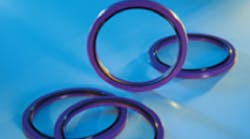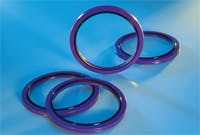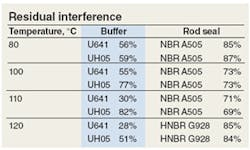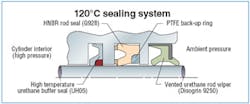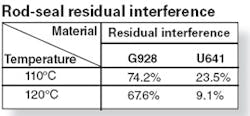Extreme temperatures and fluid incompatibility often create problems for hydraulic cylinder seals, and the challenges aren’t getting any easier. New materials and designs are necessary to meet increasingly stringent industry requirements.
The main challenges for cylinder makers today are developing products that handle excessive temperatures and resist hydrolysis and glycol fluids. Hotter ambient temperatures – caused by higher speeds, increased “under hood” temperatures (often directly linked to new environmental standards), and higher pressures in smaller packages – play havoc with the seals. Heat can harden seal materials, induce cracking at the main lip, accelerate compression set, and cause loss of interference – all of which eventually lead to seal failure.
Damage by hydrolysis and glycol exposure – often due to high humidity, new environmentally friendly bio-oils, or glycol based fluids – can make seal materials deteriorate and crumble.
Simrit anticipates that by 2010, demands for more robust cylinders in a variety of agricultural, material handling, and construction equipment applications will exceed the capabilities of most offthe- shelf sealing systems. Requirements for long-life seals will include:
• High-temperature resilience at continuous 120°C oil temperatures.
• Cold-temperature resilience to -40°C.
• High-pressure capability of 42 MPa (6000 psi) with spikes to 55 MPa (at a 0.5-mm diametral gap).
• Compatible with all hydraulic and biodegradable fluids.
• Water hydrolysis and glycol chemical resistance.
• Retrofit in standard North American, DIN, and JIS grooves.
Higher temperature ranges are especially concerning as they affect a broad range of applications. Bench testing within the Freudenberg and NOK groups, with proven correlation to field results, shows that system temperatures 10°C above recommended limits can decrease seal life by 80% or more. To address these concerns, Simrit has developed new sealing systems that help fluid-power engineers design more-robust cylinders to meet upcoming market demands.
Urethane upgrades
We evaluated new urethane and elastomeric blends against a baseline Disogrin 9250 sealing system. It consists of a buffer seal, asymmetrical rod seal, and vented rod wiper and is designed for the most-demanding applications. The Disogrin 9250 configuration with urethane seals provides 8000 to 10,000 hours of running time without failure at temperatures to 100° C, but it is not hydrolysis or bio-fluid resistant.
Several years ago, Simrit developed a proprietary urethane blend, NOK U641, capable of handling system temperatures from -25° C to 110° C. This material provides excellent cost/performance benefits. Lab and field tests show it is extremely hydrolysis and glycol resistant, handles 42 MPa pressures with higher spikes, improves the overall system temperature range, and seals can be manufactured with existing tooling. Using the baseline sealing system with U641 provides similar life to Disogrin 9250, but at an elevated system temperature of 110°C.
In many cases U641 works well, but it faces the same limitations at 120° C as Disogrin 9250 does at 110° C. The material does not immediately fail but life is significantly curtailed.
To meet future high and low-temperature requirements, Simrit recently developed NOK UH05. This urethane matches Disogrin 9250’s cold-temperature performance at -40° C while increasing long-life high-temperature system capability to an industry leading 120° C. The trade-off is that UH05 is more difficult to process and, therefore, best suited for thinner cross-section buffer seals. It’s currently in production for select cylinders.
Elastomeric alternatives
To supplement urethanes and maximize system life, Simrit has developed specially formulated elastomers for rod-sealing applications. Properly formulated elastomers take significantly less compression set than urethanes at elevated temperatures and make an excellent choice for seals if the wear and extrusion characteristics can be overcome. A lower compression set improves residual interference, an advantage when applications require longer life and leak-free performance during cycling between high and low pressures.
Although specially formulated elastomers resist extrusion much better than the majority of elastomers on the market, in general they do require back-up support to prevent extrusion at pressures above 12 MPa (1750 psi). With back-up rings and the correct extrusion gap, extrusion is a non-issue: Simrit has successfully used filled, reinforced PTFE (polytetrafluoroethylene) back-up rings with elastomeric seals at pressures beyond 42 MPa (6000 psi).
For applications that require longer life than possible with U641 urethane seals at 110°C, Simrit offers NOK A505 NBR (nitrile butadiene rubber). Field results show that the switch can double seal life in high-temperature applications. This combination of urethane buffer and NBR rod seal – with a back-up ring -- has been used in Japanese cylinders for more than five years with proven results.
For systems to meet the 120°C requirement, Simrit can substitute UH05 urethane for the buffer seal and a special HNBR (hydrogenated nitrile butadiene rubber) NOK G928 for the rod seal. This is a hydrolysis and glycolosis-resistant option for standard and biohydraulic fluids. The HNBR rod seal does require a back-up ring to prevent extrusion. The G928/UH05 combination is the best design for long life at extreme temperatures, and is currently in production for select cylinders.
Fluid compatibility
The U641, UH05, A505, and G928 materials all performed well in the lab when immersion tested in various biodegradable and glycol-based oils, with U641 results slightly better than UH05 on the urethane side. Both elastomers operate well in these oils.
Next, we conducted accelerated performance tests at various temperatures. This consisted of an on/ off cycle between 0 and 42 MPa (6000 psi), 8 sec/cycle, 1-m stroke, 0.4 m/sec speed, and 250 km total travel. Tests were conducted in an aggressive biodegradable oil to determine the effect on all materials. All seals passed without leakage, with results shown in the Residual Interference table.
The effects of compression set on the U641 buffer seal are seen in a drop in residual interference near the material’s temperature limits. Note that the buffer would continue to work at high pressures as hydraulic force actuates this seal; leakage at low pressures is not desired, but would still be caught by the rod seal. The main function of the buffer is to protect and extend the life of the rod seal, and not necessarily prevent 100% leakage. The rod seal needs lubrication too.
Fitting cylinders
While the JIS standard allows for a back-up ring independent of the rod seal, North American and DIN standard grooves often do not. This creates an issue with the retrofit of new sealing systems into existing cylinder grooves. To address this challenge, Simrit developed a design that integrates the back up into the seal.
Called the IUY rod seal, it is incorporated into a system using the UH05 urethane buffer, G928 HNBR rod seal, and Disogrin 9250 urethane wiper. It was on/off cycle tested at 110° C and 120° C for 500 km (0.4 m/sec) at 32 MPa (4650 psi) for comparison against a U641 rod seal and buffer. Residual interference results show the systems did not leak at either temperature, but the effects of compression set are apparent in the urethane seal, especially at 120° C. The HNBR G928 rod seal demonstrated significantly higher residual inter ference i n both cases. These results directly correlate to longer system life.
Joel Johnson is vice president of technology at the Simrit Div. of Freudenberg-NOK, Plymouth, Mich. For more information, call (866)274-6748 or visit simritna.com.
